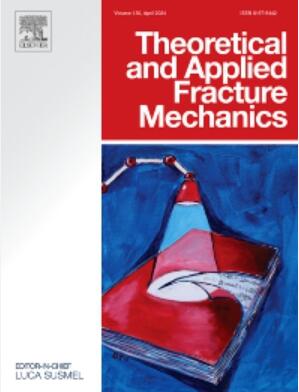用CT、SENB和SENT试样对X52钢管断裂韧性进行了实验表征
IF 5
2区 工程技术
Q1 ENGINEERING, MECHANICAL
引用次数: 0
摘要
本实验研究了X52钢管在不同初始裂纹长宽比下的断裂韧性,分别采用致密拉伸(CT)、单边缘缺口弯曲(SENB)和单边缘缺口拉伸(SENT)试样几何形状。利用数字图像相关(DIC)技术测量裂纹张开位移(即CTOD和CMOD)和裂纹扩展。在加载过程中,新的裂纹尖端被定义为在裂纹区域(即裂纹区域的一半区域)中定义的兴趣区域内垂直于裂纹平面的最大应变点(即纵向应变)。给出了CT、SENB和SENT试件在不同裂纹比下的荷载-裂纹张开位移记录和阻力曲线,从而深入了解了约束条件和初始裂纹长-试件宽比的影响。在试验(CT、SENT和SENB)中获得的临界CMOD、CTOD和j积分值(即与最大载荷对应的值)作为每个试样的单点断裂韧性的度量,可以反映与不同试样类型和裂纹长度相关的裂纹尖端约束的变化。SENB试样的结果与在X52钢管上进行的典型的类似试验结果比较好。研究结果揭示了同一种钢材不同试样类型的断裂韧性之间的关系,有助于管道材料断裂韧性数据库的开发,表明对单一断裂韧性试验的依赖是不够的。由于每个试样的几何形状和加载条件代表了不同程度的约束。因此,来自不同测试的断裂韧性预测并不直接相关,降低了它们在工业应用中的可靠性。本文章由计算机程序翻译,如有差异,请以英文原文为准。
Experimental characterization of fracture toughness of X52 pipe steel using CT, SENB, and SENT specimens
This experimental study investigates the fracture toughness of X52 steel pipe using compact tension (CT), Single Edge Notch Bending (SENB), and Single Edge Notch Tension (SENT) specimen geometries at different initial crack length-to-specimen width ratios. The Digital Image Correlation (DIC) technique is utilized to measure crack opening displacement (i.e., CTOD and CMOD) and crack extension. During loading, the new crack tip is defined as the point of maximum strain perpendicular to the crack plane (i.e., longitudinal strain) within a defined area of interest in the cracked zone (i.e., half area of the crack zone). Load-crack opening displacement records and resistance curves for CT, SENB, and SENT specimens are presented at various crack ratios, providing insights into the influence of constraints and initial crack length-to-specimen width ratios. Critical CMOD, CTOD and J-integral values (i.e., values corresponding to the maximum load) obtained in the tests (CT, SENT and SENB) are presented as a measure of single point fracture toughness for each of the specimens, which could reflect the variation in crack tip constrains associated with varying specimen type and crack lengths. The results of the SENB specimens compared well with a typical similar test conducted on X52 pipe steel. The results shed light on the relationship between fracture toughness obtained from different specimen types for the same steel material and contribute to the development of pipeline material fracture toughness database, showing that dependence on a single fracture toughness test is insufficient. Since each specimen geometry and loading condition represents a different level of constraints. Consequently, fracture toughness predictions from different tests are not directly correlated, reducing their reliability for industrial applications.
求助全文
通过发布文献求助,成功后即可免费获取论文全文。
去求助
来源期刊

Theoretical and Applied Fracture Mechanics
工程技术-工程:机械
CiteScore
8.40
自引率
18.90%
发文量
435
审稿时长
37 days
期刊介绍:
Theoretical and Applied Fracture Mechanics'' aims & scopes have been re-designed to cover both the theoretical, applied, and numerical aspects associated with those cracking related phenomena taking place, at a micro-, meso-, and macroscopic level, in materials/components/structures of any kind.
The journal aims to cover the cracking/mechanical behaviour of materials/components/structures in those situations involving both time-independent and time-dependent system of external forces/moments (such as, for instance, quasi-static, impulsive, impact, blasting, creep, contact, and fatigue loading). Since, under the above circumstances, the mechanical behaviour of cracked materials/components/structures is also affected by the environmental conditions, the journal would consider also those theoretical/experimental research works investigating the effect of external variables such as, for instance, the effect of corrosive environments as well as of high/low-temperature.
 求助内容:
求助内容: 应助结果提醒方式:
应助结果提醒方式:


